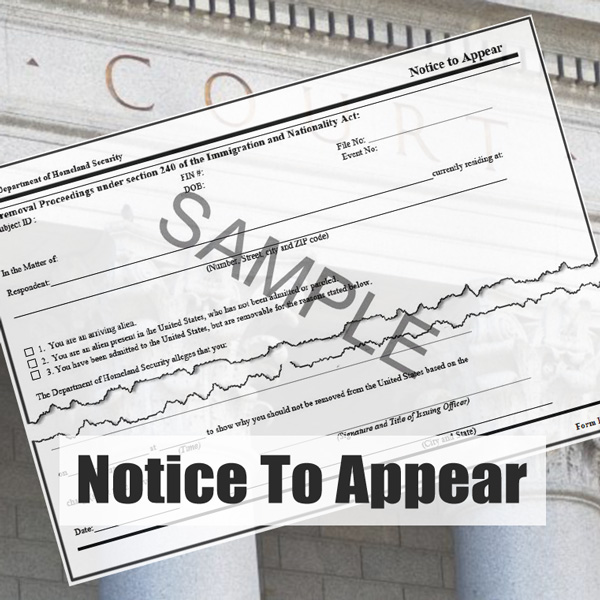Form I-862 Notice To Appear In Immigration Court

An In-Depth Look at the “Notice To Appear” Document
I have previously explored how immigrants first find themselves in immigration court proceedings and we discussed what you should know if you receive a Notice to Appear. The NTA is one of the most critical documents in the process, so this week we take a in-depth look.
This is what the NTA looks like. At the top is some very important information — the Respondent’s name, address (or what the Department of Homeland Security believes is the current address), and the alien registration number. The alien registration number, commonly known as the “A number”, is how the court (and many of other immigration agencies) keeps track of individuals.
Government’s charges
Let’s skip ahead on the page a little bit. In the bottom half of the NTA (or sometimes on the addendum page), it says “on the basis of the foregoing, it is charged that you are subject to removal from the United States pursuant to the following provision(s) of law . . .” This is where the government (specifically, the Department of Homeland Security) lays out the sections of the Immigration and Nationality Act that it charges have been violated. Or, said another way, this is why the government believes that an individual can be deported. Let’s take a look at some common charges:
“Section 237(a)(1)(B) [of the INA] in that after admission as a nonimmigrant . . ., you have remained in the United States for a time longer than permitted.” This is commonly known as the “overstay” charge: an individual entered the United States with proper authorization (as a tourist, or as a temporary employee), but remained in the U.S. after that authorization expired.
“Section 237(a)(2) . . . in that you are an alien who . . . has been convicted of a crime involving. . .”. Under this section, the government may deport individuals who have been convicted of crimes involving theft, fraud, sexual abuse, drugs, and rock and roll.*
“Section 212(a)(6)(A)(i) [of the INA] in that you are an alien present in the United States without being admitted or paroled.” This is the “catch-all” charge: The government isn’t sure how or when an individual entered, but a check of the database indicates that the Respondent has no current authorization to be in the United States.
* I’m kidding about the rock and roll — just making sure you are paying attention.
Factual Allegations
As in a criminal complaint, the alleged facts are geared toward supporting the government’s charges. In the criminal justice system, the prosecutor has the burden of proof to show that the evidence supports that a crime has occurred. In immigration, the government has the burden of proof to show that an individual is deportable. If the Department of Homeland Security is unable to meet that burden, then the Immigration Judge may “terminate proceedings” and decide that the government has failed to meet its burden to prove that an individual is subject to deportation from the United States.
The first factual allegation is always “You are not a citizen or national of the United States.” This is because U.S. citizens cannot be deported. (Or they’re not supposed to be.)
For “overstays”, the factual allegations usually include the date of entry to the United States, the non-immigrant category at entry, and the date that the authorization to remain in the United States expired. The next allegation is usually “you have remained in the United States longer than permitted.”
For the “we have no idea how you got here” cases, the factual allegations state that a Respondent entered “the United States at or near an unknown place, on or about an unknown date.”
For the “we want to take away your green card” cases, the factual allegations will state the date that an individual became a lawful permanent residence and the events that occurred afterward that trigger deportability. For instance, “you were, on _(date)__ convicted in the Superior Court of California for the offense of _____ in violation of Section ___ of the California Penal Code.”
“Ordered To Appear”
If you don’t understand anything else on the NTA, this is the section to read. It states the date, time, and location of the Immigration Court at which a Respondent must appear for the first hearing in front of the Immigration Judge. (And we’ve already covered what happens if an individual does NOT appear in court.)
What happens if this section says “on a date to be set at a time to be set”? That makes it even more important to make sure that the Immigration Court has the correct address. At some point, the Court will send a Notice of Hearing that provides the vital information regarding the date and time of the hearing.
Important Stuff in the Fine Print
The second page of the NTA contains important advisals:
Respondents may be represented by counsel in immigration court. However, the government does not provide counsel or pay for the representation. (There have been proposals to compel the government to provide counsel for unaccompanied minors and for the mentally ill.)
Respondents have the right to present evidence, challenge the government’s evidence, cross examine witnesses, apply for relief from deportation, and appeal any adverse decisions by the Immigration Judge.
And, not to put too fine a point on it, but that requirement about notifying the Department of Homeland Security and the Immigration Court of any address changes: right there on page 2.
If you are interested in discussing your situation in more detail, I invite you to contact me.
 Immigration Visa Attorney Blog
Immigration Visa Attorney Blog

